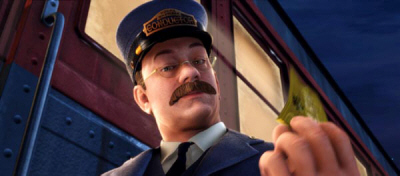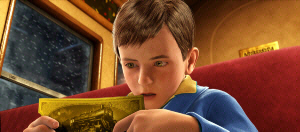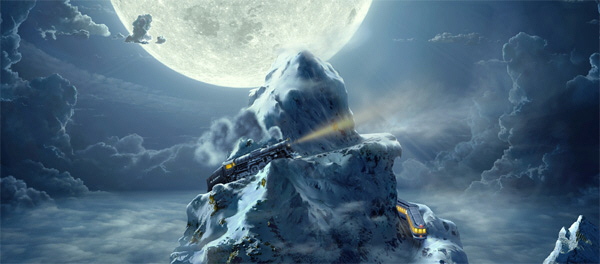Making movies. Enjoying movies. Remembering movies.
THE SCREENING ROOM
Related Articles:
|
By
Rick Mitchell

Two
reasons have been advanced for the commercial disappointment of this film
to date: the poor timing of its release at the same time as “The
Incredibles” and “The SpongeBob Squarepants Movie” and imperfections in
the technology. I'd like to advance a third: that this is the first CGI
example of why I've felt most of the recent traditional cel animated films
have failed, that they were the wrong subjects to do in animation for the
actual target audience.
What is the “actual target audience"
for “The Polar Express”? The main characters are kids who are losing
their belief in Santa Claus. This is usually kids between 8 and 10
years-old. Kids at that age are also more aware of the difference between
live action and animation, and are more likely to be affected emotionally
by something they perceive as real as opposed to what is clearly a
"cartoon." This is particularly true with the action sequences Zemeckis
supposedly added to the story, and which are played up in the film's
trailers. For them, “Polar Express” looks no different than “Titan A.E.”
(2000), “Treasure Planet” (2002), “Sinbad” (2003), or the other cel
animated films this age group and their older brethren have rejected.
On the other hand, the old fashioned
cel animated “SpongeBob Squarepants” attracted all ages, as “Lilo &
Stitch” (2002) had done before it, and like the
CGI
cartoon features because it, and they, were clearly cartoons. When
animation was limited to the seven minute "selected short subject"
package, the lush paintings and detailed drawings of feature length
cartoons were enough of a novelty to enthrall all ages. No one seems to
have noted, however, that after “Snow White” (1937) Disney increasingly
moved away from photo-realistic depictions of humans and by the Fifties,
even heroines like “Cinderella” (1950) and “Sleeping Beauty” (1959) were
slightly caricatured. Today, when kids have ready access to all forms of
animation any time they want it, the novelty value is lost.
 |
At the same time, as they reach that
"questioning" age, "simulated" live depictions of reality are more likely
to stimulate their imaginations and emotions, even as they stimulate
curiosity about how these depictions. The roll call of live action films
whose adroit use of production design, cinematography, picture and sound
editing, music, and re-recording have affected the dreams--and
nightmares--of generations of young and old include “The Wizard Of Oz”
(1939), “The Thief Of Bagdad” (1940), “Beauty And The Beast” (1946),
“tom thumb” (1958), “The 7th Voyage Of Sinbad (1958), “The 3 Worlds Of
Gulliver” (1960), the fairy tale sequences in “The Wonderful World Of The
Brothers Grimm” (1962), and “Mary Poppins” (1964); notable failures
include Disney's “Babes In Toyland (1961), “The Blue Bird” (1976), and
“The Wiz” (1978) because someone in creative control didn't get it.
It's surprising that Bob Zemeckis
didn't get it on “The Polar Express.” Actually, any type of animation
might have been a commercial draw for the basic, somewhat saccharine
story, and more traditional techniques would have gotten around the main
complaint of the blank, expressionless nature of the human characters. In
fact, rather than the dubiously necessary motion capture technique on
which Zemeckis spent $170,000,000, it might have been better to use the
green screen/CGI
background technique of “Sky Captain And The World Of Tomorrow,” which
only cost $70,000,000 according to one source. Where that film failed is
that too many in the audience had no frame of reference for the fantasy
world it was depicting, such a technique might have created the "magic" to
attract its target audience.
And actually it may be time to rethink
the role
CGI
has come to play in contemporary films. Two clips screened at an Academy
of Motion Picture Arts and Sciences program last month were vivid
reminders of how the limitations of locked down cameras or old fashioned
motion control actually worked to enhance the reality of effects sequences
because filmmakers were forced to do shots that could believably be
photographed by a camera. CGI has brought to live action the kind of
shots the Disney company used to do with their multiplane camera,
beautiful to look at, but we knew we were watching paintings, not
recordings of reality. The overuse of such shots in recent films like
“Van Helsing” and “The Chronicles Of Riddick” mitigated against audience
involvement in them and probably were major contributors to their
rejection by audiences who were tired of such phoniness.
Bob Zemeckis has been a pioneer in
using new technology to enhance the film watching experience and was
clearly hoping to awe audiences of all ages with the technology of “The
Polar Express.” He may have succeeded better with the Imax 3-D version
(which I can't see at the moment), but otherwise miscalculated with this
subject. Perhaps the entire industry needs to rethink its approach to
using
CGI
for this purpose.
 |
Rick Mitchell is a film editor, film director, and film historian. He lives in Los Angeles.
© 2004
Rick
Mitchell.
All rights reserved Artwork ©
2004
Warner Bros. Entertaiment Inc. All
rights reserved.
